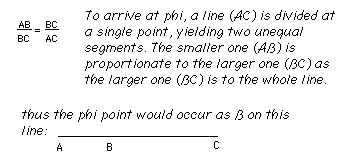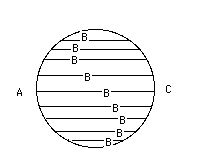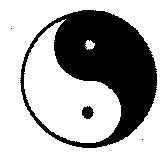In the Tao te ching a way out of dualistic thinking is given. Dualistic thinking puts two different forces or concepts opposite one another and ascribes them an independent value. This is the source of conflict. Conflict between man and woman, left and right, old and young, black and white. Dualistic thinking creates rigidity. As soon as we take an active viewpoint, judge, we are mistaken, for what may help us today may very well work against us tomorrow. Creative thinking means accepting that nothing is separate. Everything is connected. What we perceive is the field of tension between two forces, itself remaining in the background (Ch'i). Instead of two forces we are dealing with three forces. Zen calls this 'mu', no-thing, not yes, not no, not this, not that. The Tao stresses the continual change and transformation and tries to strengthen intuitive thinking.
Western dualistic thinking is by and large based on the logical and rational. Eastern thinking seems to find its source in the spatially oriented right brain-half. The subjective process is the leading theme. This dynamic flux can be found in every individual, for instance, the difference between my real self and my ideal. The relation between me and my parents, children, friends, colleagues and work. It shows in the manner I deal with my bicycle or car, and in my reaction to the universe. It is also found in every pair of concepts. When I have two sticks, the one may be long and the other short. When I have two solutions, the one may be good and the other bad. Long and short, or good and bad are possible because of the difference between long and short and good or bad, respectively. On basis of this difference the one is long/good and the other short/bad. If a third stick or solution is found, everything may change. So we see that the difference creates the opposition. However, the opposite is just as true: the opposition creates the difference. In fact the one is not short and the other not long, but I want to see them as such. And just because I project these concepts onto these objects does not mean that they are exactly that. I only have described three entities: long/good, short/bad and the difference. If one of the three changes the other two change as well, for there would no longer be a difference. The opposition is therefore no separation but a distinction. The three are connected and together create a reality. The opposition (long/short, good/bad, yin/yang) can be seen as reflecting boundaries of the same reality. However, everything changes continually 'You can step into same river only once, as the water continues to flow'), life knows no fixed boundaries. The trinity will disappear as another stick or a different solution will be found. In order to actually see the flow of the events 'emptiness' is required. The observer has to have an open mind. (cf. flexible thinking). Yin and yang can be seen as a dynamic, synergetic model for creativity. It is the creativity at work in artists who are the pioneer in the frontier of new form. They work their materials into new designs, exploring, discovering, expanding and finally dissolving the old into the new. It is the process that requires most attention in creativity.
Stuart Litvak and A. Wayne Senzee explain this very well in their highly interesting book Toward A New Brain (Frontiers of Science series, 1986, Prentice-Hall Inc.). They call it dynamic design. The ancients, they state, were masters in combining mathematics and metaphor in a fully human balance. Their law, religion, philosophy, art, and science are the rich evidence. We have more technical knowledge, but without their earth-wisdom it is a double-edged sword, the sharpest edge of which is held against ourselves. The Classical Greeks, Persians, Indians, Arabs, and others searched for proportions and found facts along the way. Western people have sought and hoarded facts alone and lost proportion - there are simply too many facts and too little room to store them in a present-day brain.
In geometry the Greeks discovered what must be the key cipher to decoding the infinities of revealed form. This is the phi (ø) ratio, or 'golden mean", stated algebraically as:
 There can be only one phi point on a given line. a line will yield a curve (logarithmic) called the 'golden spiral' when it connects the phi points of a series of progressively smaller rectangles derived from the largest. The T'ai chi (yin-yang) symbol is such a golden spiral. Digited, the 'golden ratio' is 1:1.618 ... to infinity.
There can be only one phi point on a given line. a line will yield a curve (logarithmic) called the 'golden spiral' when it connects the phi points of a series of progressively smaller rectangles derived from the largest. The T'ai chi (yin-yang) symbol is such a golden spiral. Digited, the 'golden ratio' is 1:1.618 ... to infinity.  The golden ratio is a unique proportion in that it is the only irrational (not amenable to an exact figure) number that can be subdivided endlessly. It is an ultimate symbol of the eternal and limitless possibilities of consciousness i.e. creativity in finding new ideas. It is as Chuang-tsu said: "There is no end to smallness."
The golden ratio is a unique proportion in that it is the only irrational (not amenable to an exact figure) number that can be subdivided endlessly. It is an ultimate symbol of the eternal and limitless possibilities of consciousness i.e. creativity in finding new ideas. It is as Chuang-tsu said: "There is no end to smallness."
[Go to Lilliput start] Go to Brobdingnag start page] [Go to Laputa start] [Go to Houyhhnhm start] [Go to Creative Self start][back to English Index] [Back to start page] [Back to first entry of this site]